Author: Sword of Damocles

Table of Contents:
Information:
- Release year: 2022/2023
- Country of origin: USA, Canada & China
- Colour options: Gunmetal and Satin aluminium
- Price: $799 / ~710€ ($150 discount with promo code)
- Type: Closed, over-ear
- 40 mm dynamic drivers (titanium-coated mylar)
- Preamplification: Nutube 6P1 Dual-Triode tube
- Main amplifier: Class A/B Dual Mono
- Sound Input: Bluetooth 5.3, USB-C and 3,5 mm
- Bluetooth codecs: LDAC, AAC and SBC
- Charging port: USB-C
- Battery size: 2000 mAh
- Battery life: 20 h (volume at maximum)
- Charging time: 3.5 h
- Active Noise Cancellation: ON / OFF / Transparency mode
- Features: Multipoint, Voice assistant (Google Assistant/Siri) and phone app with an equalizer
- Weight: 424 g (tested unit 430 g)
- Accessories: Carrying case and high-quality USB-C cable (AUX cables sold separately for $25-130)
Arvostelukappaleen hankintatapa: Saatu valmistajalta
There are all kinds of noise-cancelling headphones, but few stand out from the crowd in terms of core technology. Of the more specialised models, the ones that spring to my mind are those with multiple drivers, such as Heavys H1H and Noble Audio Focus Apollo. No headphones, on the other hand, have had a built-in tube amplifier. Can such a thing even work and what's the point?
Answers to these questions are provided by écoute Audio TH1 Vacuum Tube headphones, with a preamplification stage implemented with a Korg Nutube 6P1 tube. The same miniature tubes are also used in other battery-powered devices (e.g. DAPs and mobile amplifiers), as they consume little power (only 2% compared to standard tubes) and offer a distortion profile similar to larger tubes when tuned appropriately.

According to the manufacturer, the tube pre-stage in TH1 is intended to shape the sound to be more pleasant and realistic. The Class A/B dual mono power amplification also plays its own role in the overall package, which can also be considered an exceptional solution in this product category. Overall, the signal path should compensate for the lossy compression of sound in wireless listening. TH1's dynamic drivers are 40 millimeters in diameter, and their diaphragm has a titanium coating.

TH1 costs $800, which, with VAT, translates to a final price of about 900 euros when ordered to Finland. At the time of writing this article, you can get a $150 discount with a promo code, bringing the price down to around 750 euros. Unfortunately, TH1 is not yet sold in the EU; it's shipped from either Hong Kong or the United States. The company itself operates internationally across the US, Canada, and China. The name "écoute" means "listen" or "a call to listen" in French.
The current headphone version is relatively new, but some marketing materials still show an older version with a slightly different headband structure. The original release was partly funded by a Kickstarter campaign in 2022 and 2023, while the first prototypes of the headphones date back to 2019, before the COVID-19 pandemic disrupted plans. The manufacturer first integrated tubes into headphones back in 2016, so TH1's journey to a finished product was ultimately quite long. In today's market, competitors for these headphones can be considered, for example, Focal Bathys and DALI IO-12.
I received the headphones directly from écoute Audio for review. So far, I've already had the chance to provide extensive direct feedback, having communicated regularly with one of the company's co-founders for several weeks. Now, let's take a comprehensive look at the observations I've made during this time.
Packaging and accessories

TH1 arrives in a corner-reinforced cardboard box without separate product packaging. However, a decorative white sleeve has been slipped around the headphones' square carrying case. As far as I know, the product is currently sold mainly online, so the presentation feels perfectly adequate.
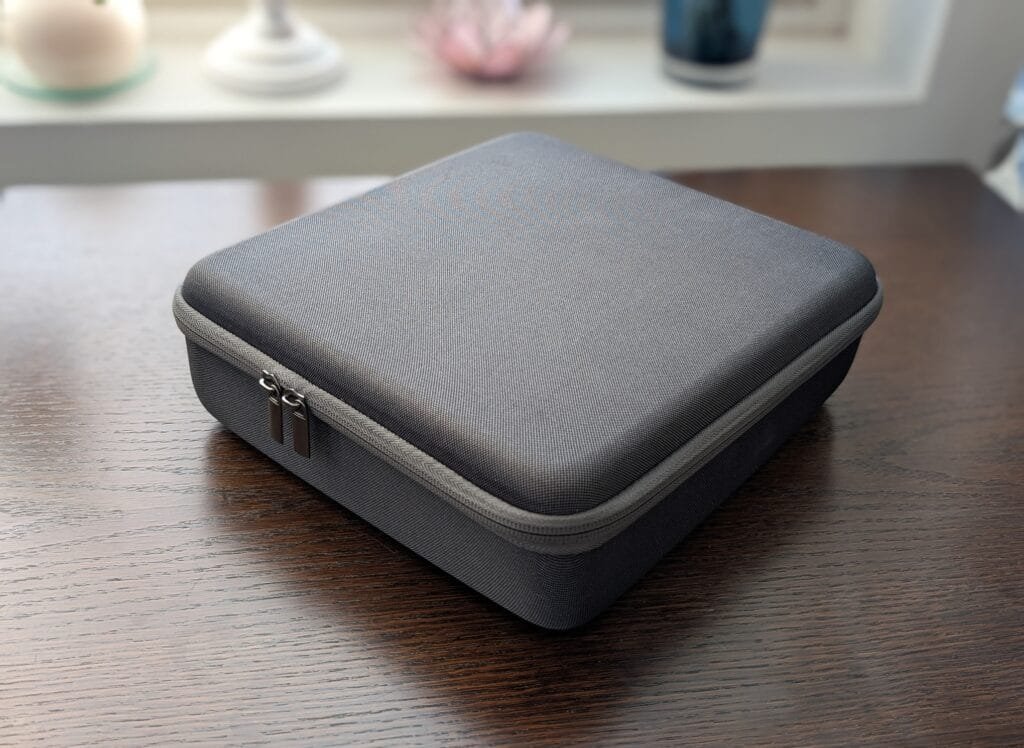
Inside the case, besides the headphones, you'll find a USB-C cable. Buyers should also receive a user manual, but I didn't get one myself – though I was able to find it online. So, there isn't much to mention regarding the accessories, but I haven't received a USB cable of such quality and flexibility with any other headphone model. I'm happy to use the cable for listening with the TH1 in addition to charging.

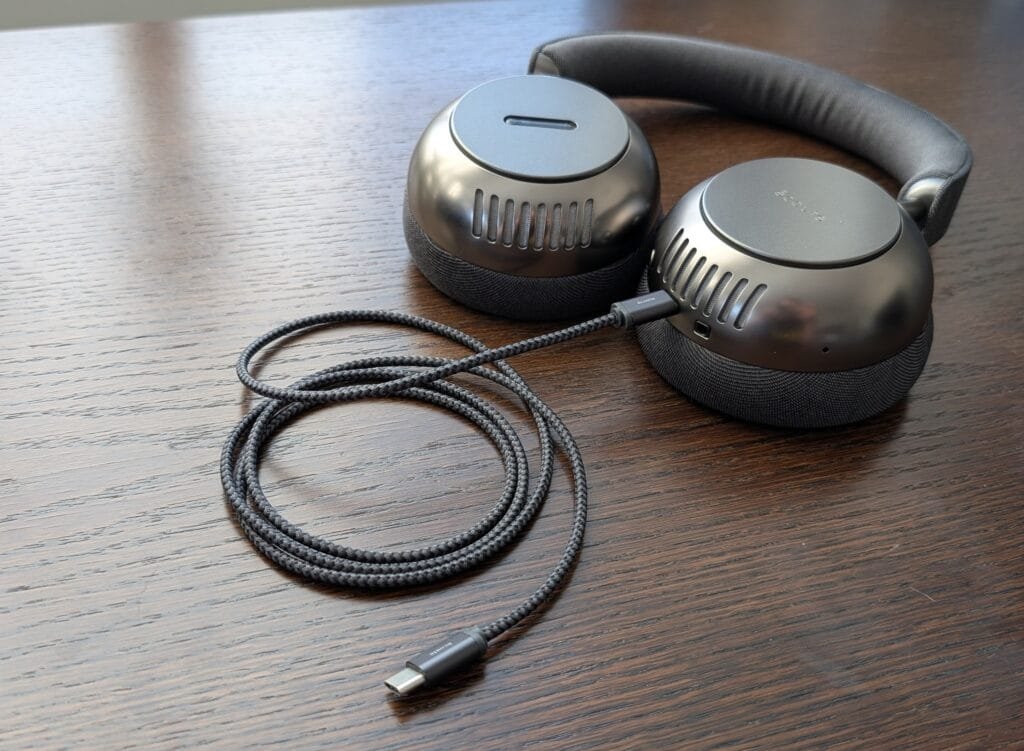
No dedicated headphone cable is included in the package, so it must be purchased separately. The most expensive option in the manufacturer's range is priced at a hefty $130, but if you opt for the Audiophile bundle, you can essentially get it for $50. A cable externally similar to the included USB-C cable would cost a more reasonable $25. Perhaps some kind of basic cable could be included in the package by default, as other manufacturers provide one?
Build and comfort
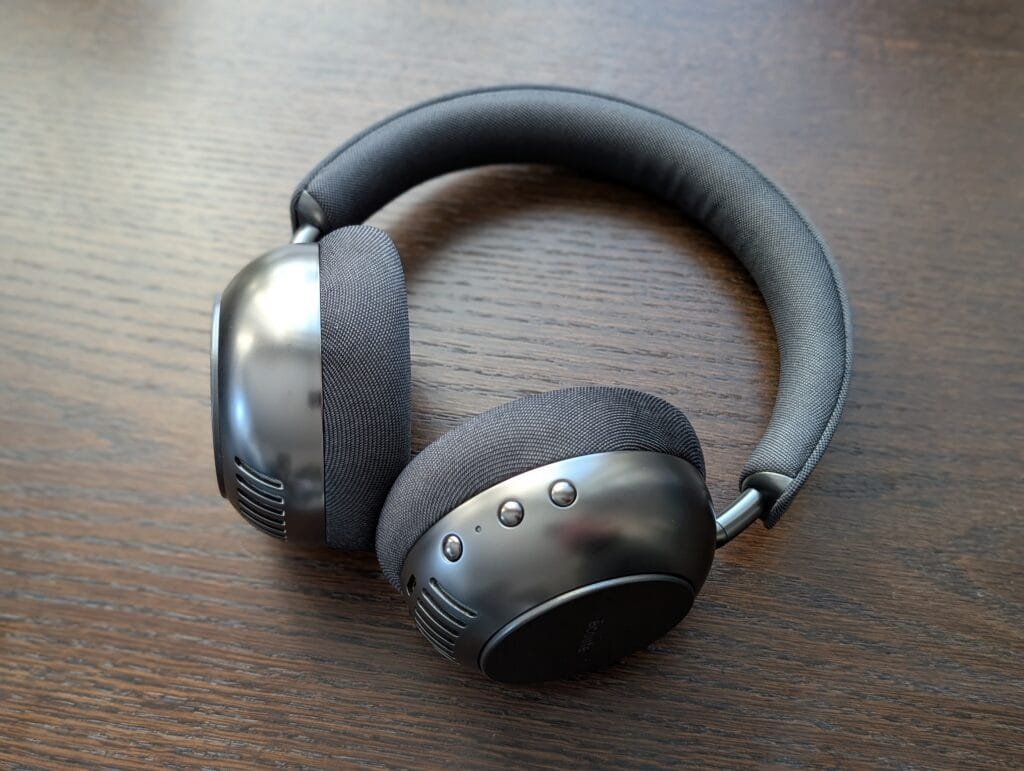
écoute Audio's headphones are quite large, and at 424 grams, they're heavier than most of their competitors. In this price range, however, I'd have been disappointed if the build was cheap and flimsy plastic. So, I'm pleased with TH1's metal earcups and headband, and the generally high impression of quality. I chose the gunmetal color option, but the headphones are also sold in satin aluminum. In that case, the memory foam padding, covered with fabric material, would be brownish. Fabric might not be the best choice for sound isolation, but it causes significantly less sweating than the synthetic leather found on many other noise-canceling headphones.


The height adjustment should be sufficient for everyone, as TH1 is almost too large for me even at its minimum setting. For those with smaller heads, the extra padding sold separately by the manufacturer might be necessary. This could also be beneficial for comfort, as the narrow headband starts to press on the top of my head during longer use. Also, some part of the round ear pads presses against my earlobes, so I wish the opening was slightly taller (current diameter is 5 cm and depth about 2.2 cm). Thus, TH1 wouldn't be entirely optimal for me to use on, for example, a long train or plane journey, but based on the test period, I don't need to complain much about the comfort. On the positive side, the clamping force of the headband is quite gentle, and the pads sit evenly around the ears, which is beneficial for the effectiveness of the noise-canceling function. TH1's ear pads are replaceable, as they detach by twisting them in a similar way to the Valco headphones or Audeze Maxwell.
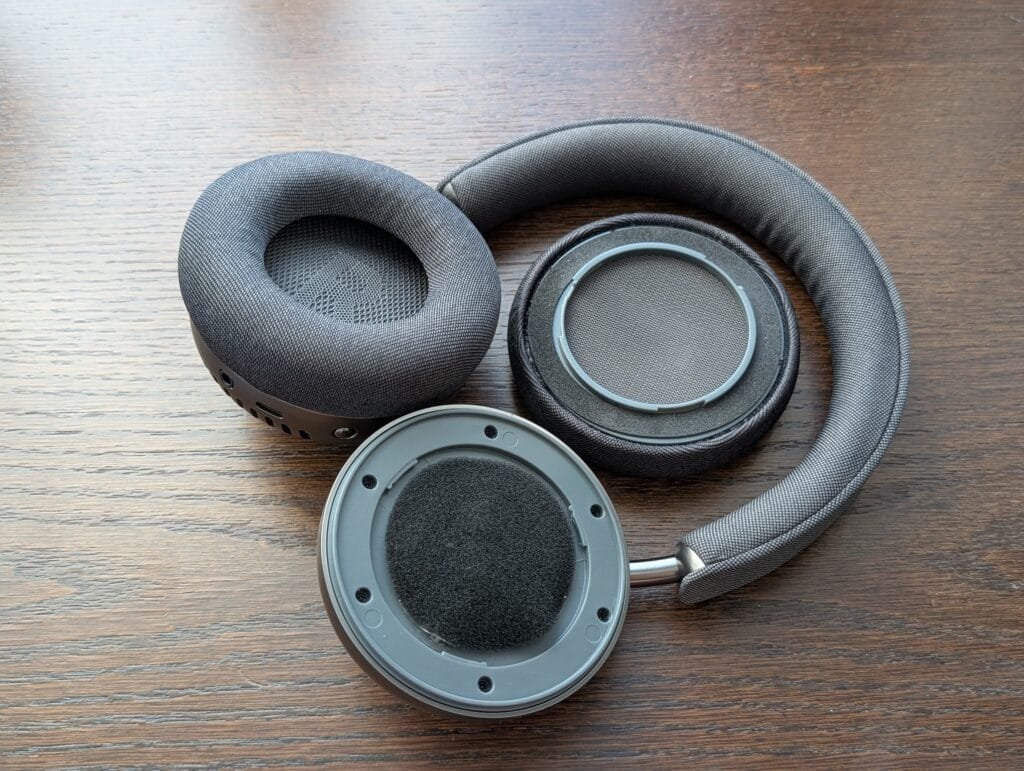
écoute Audio has placed all the functions on the right earcup, which is a slight departure from the norm. Often, buttons and connectors are spread across both earcups, but in TH1's case, the left earcup is entirely dedicated to the amplification circuit. The Korg Nutube 6P1, which serves as a major selling point, glows a turquoise color beneath a glass window installed on the side of the earcup, simultaneously revealing that the headphones are powered on.

If anyone wonders whether the Nutube 6P1 is a genuine tube, the answer becomes clear when you tap the left earcup or, for instance, open a drink can. Such vibrations cause the glass tube to "ring" at a high frequency for a few seconds. I don't find this interference particularly annoying, but it is a clear drawback of the tube implementation. Fortunately, moving around with the headphones on or walking does not cause any extraneous noises, so unless you fiddle with the left earcup, you generally won't notice the tube's presence. The Nutube 6P1 is designed to be highly resistant to impacts, and its projected lifespan is stated as 30,000 hours, so there should be no need to replace the tube.
Thanks to its low power consumption, the tube also doesn't generate much heat, so the ventilation holes at the bottom of the earcups are purely decorative. However, upon opening the headphones, I noticed the grilles were partially open, so in theory, they could have a minor effect on the cup acoustics. On the other hand, the drivers are enclosed separately from the rest of the earcup's interior, except for a single fabric-covered opening, meaning the effect would primarily extend to bass frequencies. My wife pointed out that TH1 leaks more sound outwards than usual, which could very well be due to these grilles or the fabric ear pads.
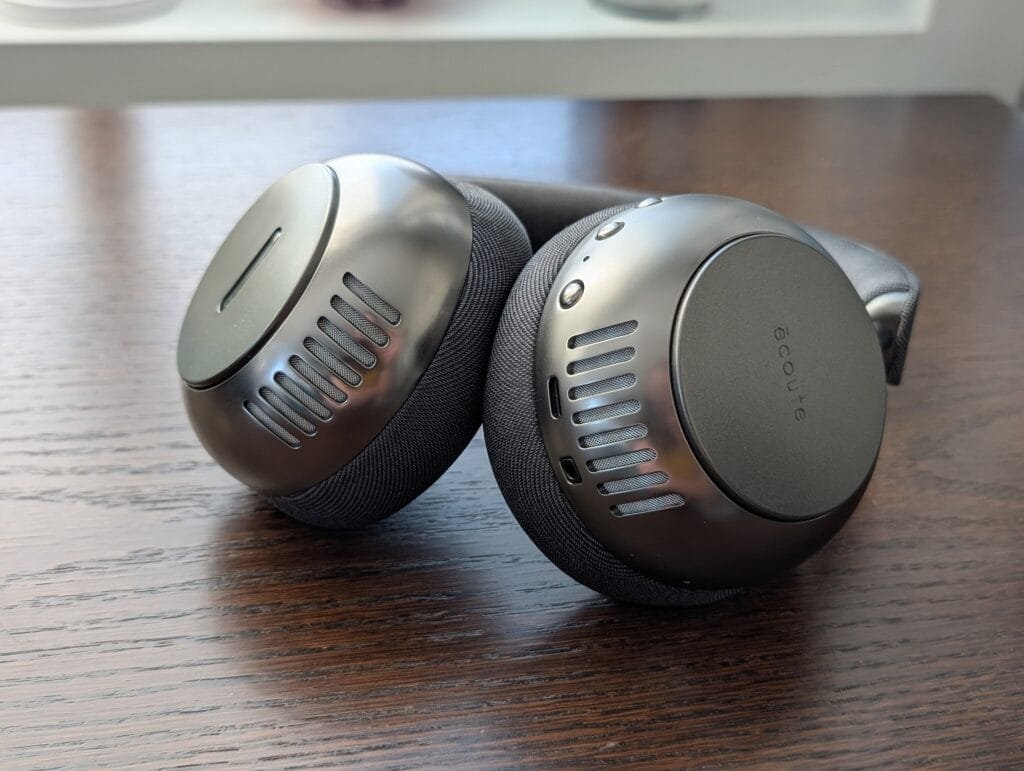
TH1 is controlled by three round buttons and a button panel located on the side of the right earcup. Pressing this panel vertically adjusts the volume, while pressing it horizontally allows you to skip tracks forward or backward. All buttons function sufficiently well, though the feedback isn't the crispest or clearest. I needed the user manual to figure out how to power on the headphones. The power button isn't marked in any way, but I eventually found it in the middle of the row. Perhaps the surface of this button could be made to feel slightly different, so it's automatically recognizable?

Bluetooth technology and battery life
The headphones support Bluetooth 5.3, offering Multipoint capability and support for the high-quality LDAC codec. For other codecs, support is limited to AAC and SBC, meaning the AptX family is absent. On my Google Pixel 9 phone (and other Pixel phones), LDAC had to be manually activated via Android developer settings, as otherwise, due to Google's unique configurations, TH1's default codec was AAC. This change had a positive impact on sound quality. For me, LDAC works steadily with a 660 kb/s connection, while 990 kb/s tends to cut out. I have no complaints regarding the reliability or range of the Bluetooth connection. The headphones have, however, shut themselves off a couple of times during use, but the reason is likely elsewhere.
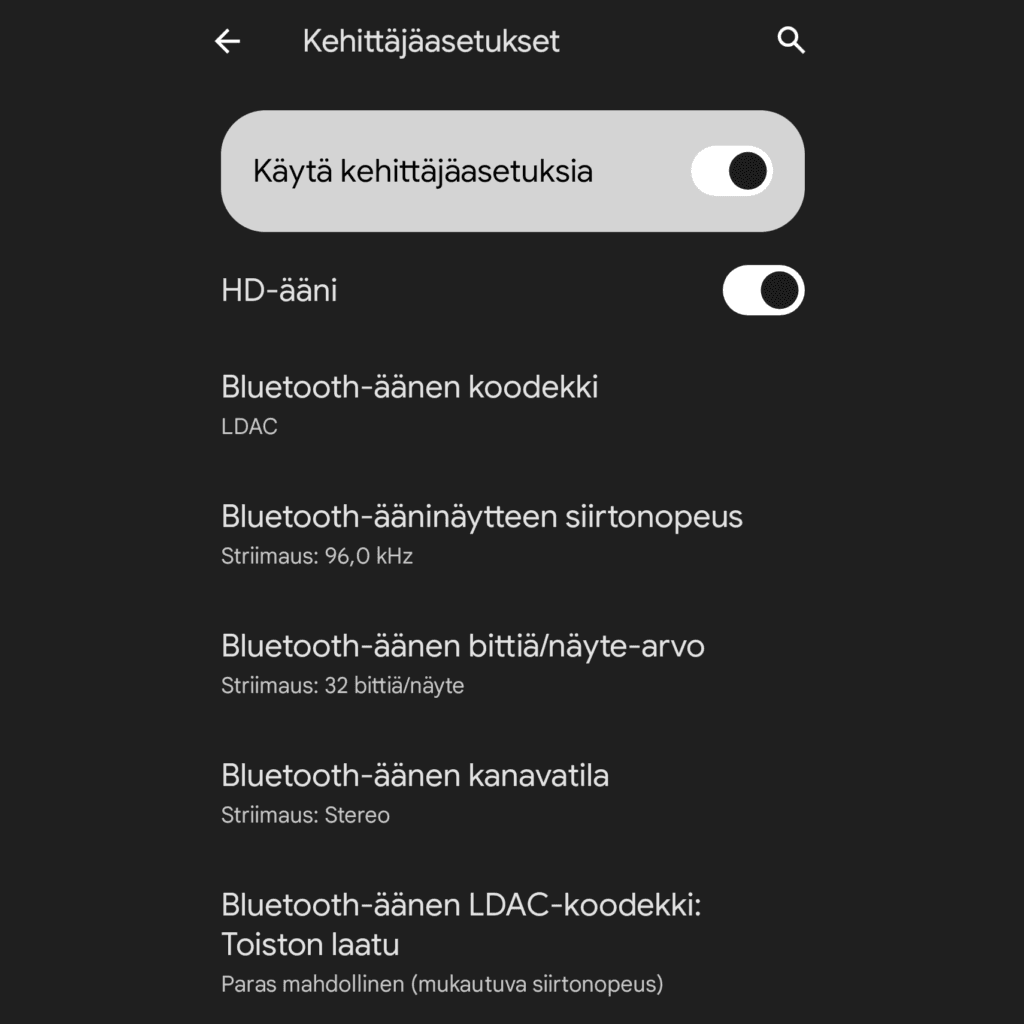
The electronics within TH1 presumably consume more power than usual, as the manufacturer only promises a battery life of 20 hours, even though the headphones' 2000 mAh battery is larger than that of Audeze Maxwell, which boasts up to 80 hours of use. In reality, however, TH1's battery life seems longer than promised, because the 20 hours is measured with the maximum volume, which I don't need. The headphones play at a suitable loudness even at the halfway point of their volume range. I haven't experienced the volume adjustment range to be as uneven as, for example, with Focal Bathys (unless the situation has changed with updates), which, to my taste, always played either too quietly or too loud.
écoute Audio states the charging time as 3.5 hours, which also seems like a slight overestimate. If needed, the headphones can function passively without power, but in this case, the built-in amplifier and DSP are bypassed, meaning the headphones' most significant selling point is lost. With battery power, everything works as designed, regardless of whether TH1 is listened to via Bluetooth, a USB cable (supporting lossless 32bit / 384kHz audio), or an analogue headphone cable.
Beta phone app and additional features
At the time of writing my review, écoute Audio's Spec mobile app was not yet fully complete or available for download from app stores. However, I received a download link to a beta version, which, despite a few quirks, worked quite well. Several new versions were also released during the test period, so the final release should be be near.

The app allows for changing the sound profile and equalizing the frequency response using 8 fixed sliders. Additionally, a limit can be set for the volume, which can conveniently smoothen the steepness of, for example, a phone's volume adjustment steps. In the future, the headphones' firmware version can also be updated through the app.

The app offers a large number of pre-defined sound profiles, which users can freely modify into new profiles, with the ability to save up to five custom profiles. In addition to music genre specific settings and bass & treble boost, there's also a profile called "Harmon" aimed at reproduction in line with the Harman target curve. The écoute default profile also activates a form of equalization, while the "flat" profile sets all sliders to zero. I ended up customizing a couple of my own profiles, which écoute Audio decided to officially include in their app. The selected profile is always saved to the headphones, making it available across all different source devices.
Active Noise Cancellation (ANC)
TH1 includes active noise cancellation (ANC) and a transparency mode that amplifies ambient sounds, both of which are optional to use. The headphones always start by default in a state where the ANC function is turned off. Transparency mode is activated with a single button press, while noise cancellation is turned on with two presses. As of now, the mode cannot be changed via the app, nor can the level of noise reduction or transparency be adjusted.
ANC seems to perform in a similar manner to other premium-level wireless headphones primarily focused on good sound quality. In other words, when compared to manufacturers focused on developing noise-cancellation technology, such as Sony and Bose (concluded with QuietComfort SE), they remain quite far behind. Nevertheless, any form of noise reduction is beneficial in noisy environments. The only rather unfortunate aspect of TH1's ANC function is the hiss and static it generates. This is easily noticeable if you're not simultaneously listening to something through the headphones. While the noise doesn't stand out when music is playing, the manufacturer could improve in this area, primarily because many passionate audiophiles shy away from such extraneous sounds and, partly for that reason, from noise-cancelling headphones in general.
I did a quick comparison of TH1's noise reduction performance with Cambridge Audio Melomania P100, Bowers & Wilkins PX7 S2eand Valco VMK25and found that écoute Audio's headphones ranked last among the four in terms of attenuating both low and mid-frequencies. The superiority of Melomania P100 and PX7 S2e was clearly noticeable, while VMK25 performed only slightly better. The background hiss was also strongest with TH1. However, regarding the transparency mode, I found it similar to PX7 S2e, as both sound quite natural. In contrast, at the other extreme, VMK25 unnaturally sharpens all sorts of hissing sounds, such as the sound produced by rubbing your fingers together.
Given that TH1 is écoute Audio's first product, I don't believe its active noise cancellation needs to be top-tier just yet. In my assessment, it's roughly on par with Focal Bathys, which I consider quite acceptable. If the manufacturer can improve the effectiveness of the noise reduction even slightly in their next headphone models, they would already be on the level of most competitors. At the same time, they should also aim to reduce the hiss if possible. On a positive note, I haven't observed any significant bugs in the ANC function. Furthermore, walking doesn't cause thumping noises, and even a slight wind doesn't create major disturbances in the soundscape.
Microphone sound quality
The headphones also handle phone calls. I tested the microphone relatively quickly and found it to be functional with quite typical sound quality, which I don't mean as a criticism. As you might gather, I'm not particularly interested in microphones in this type of headphone.
Headphone sound quality
TH1 can be listened to in both active mode (Bluetooth, USB-C, and 3.5 mm) and passive mode (3.5 mm). I cannot recommend passive mode, as the headphones' built-in electronics and DSP are bypassed. In active mode, the tube pre-stage and écoute Audio's digital fine-tuning of the frequency response are available, or alternatively, the user's own equalization. However, it's worth noting that TH1 sounds slightly different depending on whether its ANC is on or off. The transparency mode and ANC OFF mode have similar frequency responses. écoute Audio states that they drew inspiration from the Harman target curve for the tuning, but made fine adjustments to it with the aim of offering a more linear bass response, even clearer mids, and slightly brighter and airier treble.
I typically don't mention the channel balance of headphones, but this time it's pertinent because in my review unit, the upper mids play louder at left side. Consequently, a vocalist isn't perfectly centered in the soundstage, and the sound on the left side is generally sharper. For some reason, the balance also varies depending on which mode I'm using: the channels differ most clearly when ANC is on, while the differences are smallest in passive mode. Generally, however, the balance should be better than that of my test unit, as the manufacturer's engineer stated the problem should be an isolated case.
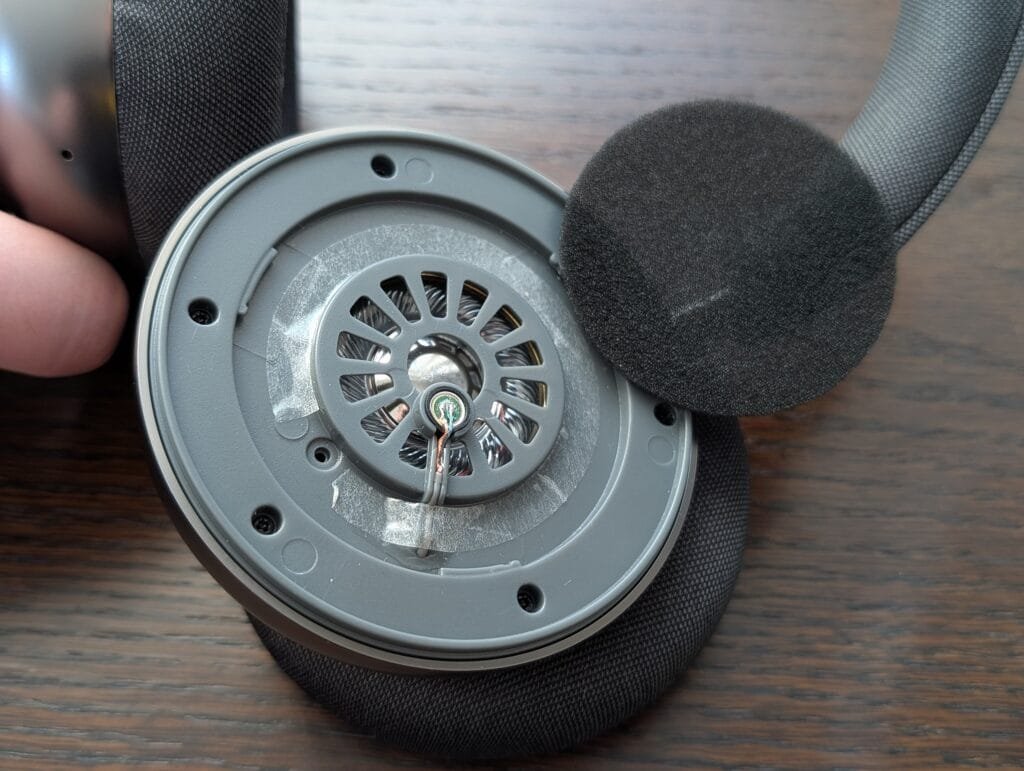
Measurements
Our frequency response measurements have been made with a clone IEC-60318-4 coupler and KB501X pinnae. The Harman target curve from 2018 is used as a reference point and generalization of the headphone response that would sound good to most people. For more information on the measurements and their accuracy, see Headphone Measurements. All the measurements including TH1 can be found and compared on Squiglink avulla.
Note: Active mode measurements were conducted with a Bluetooth connection, where treble plays approximately 1 decibel louder from 3 kHz upwards than when measured with a USB cable.
Frequency response in passive mode:

In passive mode, the frequency response is based on mechanical tuning. Since the drivers are tightly enclosed, their adjustment possibilities have been limited. Thus, the response is very bass-heavy and colored in the high frequencies. However, as a DSP starting point, the response seems good, as there isn't significant local variation. Despite its unnaturalness, the response is quite smooth.
Channel balance with ANC function ON:
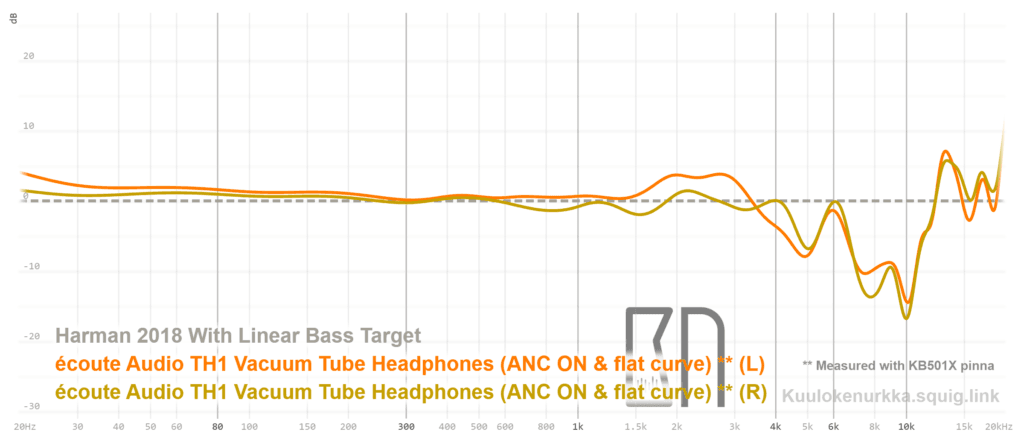
The left side reproduces the 1.5–3 kHz range more strongly, while the area around 4 kHz is louder on the right side – unfortunate, but not entirely uncommon in other noise-canceling headphones either.
Frequency response ANC ON vs. ANC OFF:
écoute profile (default setting)
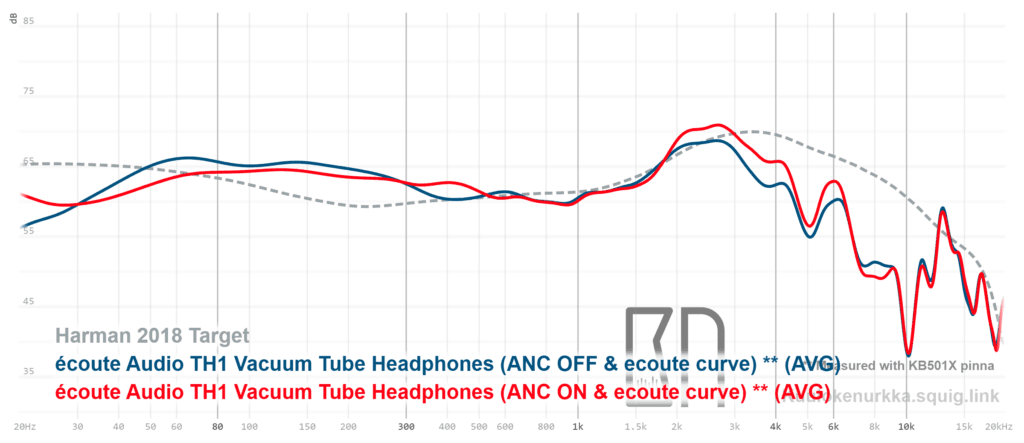
Harmon profile

Flat profile
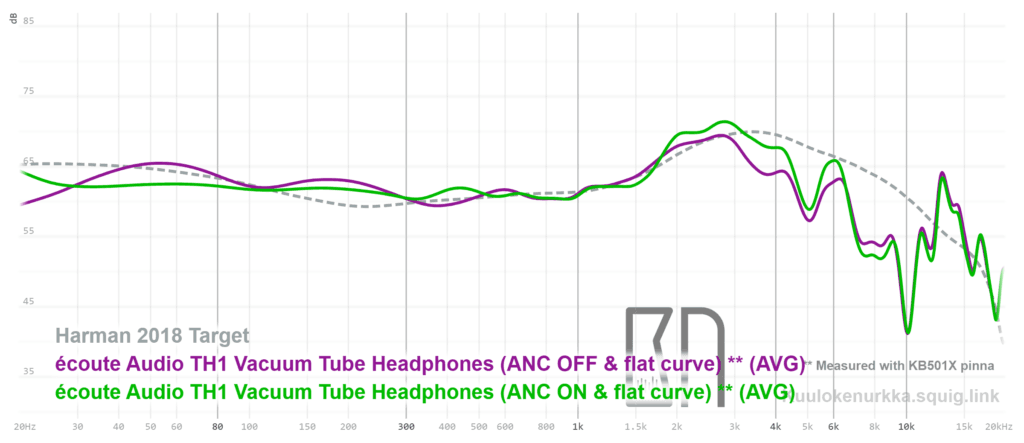
Sound observations
écoute Audio's DSP appears to work most optimally with ANC activated, if the goal is the most balanced sound possible. Without ANC, bass becomes fuller, and upper mids become calmer. Nevertheless, with the écoute sound profile, the presentation is in any case warm and mid-frequency-focused, with highs playing softly in the background. The significantly elevated 100-400 Hz range and soft treble prevent the sound from being particularly clear, even though the level of upper mids is properly set to be energetic between 1–3 kHz. The mids certainly sound loud, but quite veiled.
The end result, in my opinion, doesn't quite match the headphones' marketing, but it's still an improvement compared to the even more colored "Harmon" profile. Either my specific headphones behave weirdly, or the tuning hasn't quite hit the mark yet for the lower mids and treble. The "flat" profile (all sliders zeroed) found in the app feels considerably more purposeful to me. With this, I consider TH1 a very good headphone, especially if écoute Audio's target audience is assumed to prefer a neutral sound over heavily boosted upper bass.
With ANC and the "flat" profile activated, TH1's low frequencies are quite linear, similar to open-back headphones. At the same time, the presentation still has some pleasant warmth. The energetic upper mids, in turn, draw attention to the detail of instruments and the vocalist's articulation to such an extent that my primary focus is always on this area. Treble, however, still sounds a bit soft for my taste between 7-10 kHz, but it would be possible to get used to it. I would gladly listen to such clear and mid-frequency-focused sound with even a slightly more critical approach. In my test unit, the left side sometimes sounds aggressive and somewhat thin between 2–3 kHz, so I've found turning off ANC to be a good alternative for relaxed listening. Then, upper mids are reproduced slightly more naturally to my taste, and the sound, with its warmth and softness, feels somewhat analog. The trade-off is a loss of some clarity compared to listening with noise cancellation on.

The tube pre-stage seems to affect the soundstage most significantly, as it draws attention with its interesting spaciousness and layering. The sound immerses me better than is typical for wireless headphones, and generally feels authentic. The feeling is actually somewhat similar to listening to a well-matched headphone and tube amplifier combination. Thus, I believe TH1 has potential and successfully differentiates itself from traditional noise-canceling headphones. Despite the darker treble, I don't find the presentation too muffled, but critically evaluated, this is the area with the most room for improvement. In my opinion, it's highly recommended to utilize the equalization options offered by the app, as suggested by écoute Audio. They can make TH1 even better.
Equalization
I won't be presenting my "own" sound profiles found in the app at this time, as they are still incorrectly named in the latest version, and the situation will likely evolve somewhat in the future. In any case, I've further refined these profiles based on more extensive testing, so I'll now focus on three different equalizations. Two of these are suitable for use with the ANC turned on, and the third is for use in ANC OFF mode.

My self-named "écoute neutral" profile is, in essence, an even more neutral version of the "flat" profile. The biggest change was a slight rebalancing of the upper mids and an increase in treble. This makes the sound brighter and clearer compared to the "flat" profile. To my ears, the change feels as if a thin veil is removed between me and the music without otherwise significantly altering it.
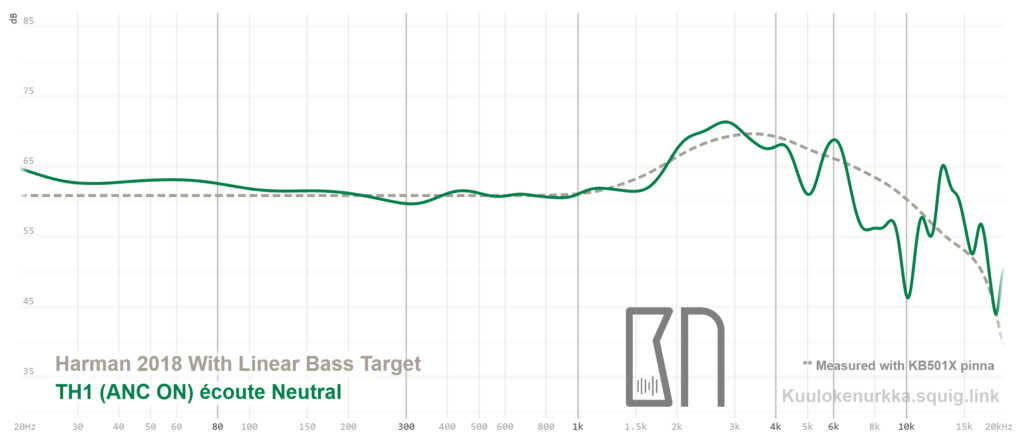
I call my second setup "Harman-ish" (very similar profile should be available in the app), because I adjusted it to follow Harman Target curve to the extent possible with the provided sliders. I am quite satisfied with the result, as with these settings, TH1 offers robust bass with clear mids and energetic highs. The listening experience is engaging, yet I can still listen to the headphones for extended periods of time. The quite similar profile, which is available as a preset in the app, offers slightly brighter treble above 10 kHz.
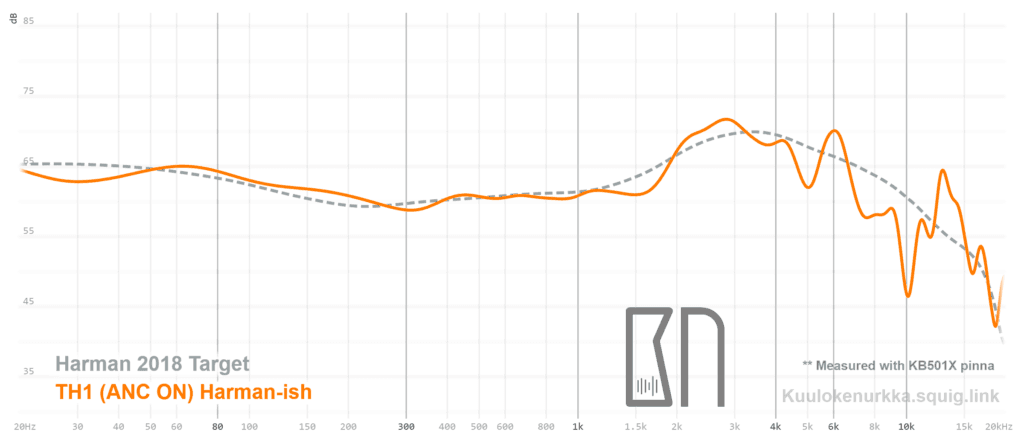
My third profile, "Clear," is intended for use without active noise cancellation, but otherwise, the idea was to create a balanced and clear sound. The result turned out to be largely the most natural due to the linear upper mid-frequencies. Additionally, it was possible to boost the treble without the 6 kHz region drawing too much attention. The bass is also pleasant to my taste, and the slight mid-bass emphasis adds some fun factor.

Once the frequency response is tuned for better balance, my attention is drawn to TH1's spacious soundstage, where separation is astonishingly layered and vibrant, even over a Bluetooth connection. Switching to a USB cable removes the last hint of harshness and treble compression, further improving the sound. For example, a snare drum snaps a bit more naturally. On the other hand, comparing signal quality is quite difficult, as treble generally seems to play a bit quieter when using the USB cable.
From a sound quality point of view, I've found that I prefer the ANC OFF mode, as this keeps background noise to a minimum (with the USB cable there is still some noise). In this case, the soundstage opens around me pleasantly evenly, so the headphones kind of disappear. There's empty space between the different parts of the music, and the details pop out with an edgy presence and precise delineation. Moreover, the sounds that move from close to far away seem to travel as if to infinity without hitting a wall in the same way as with some closed back headphones. At the same time, the vocalist is successfully separated from the other instruments, which further enhances the authenticity and immersiveness. Only the poor channel balance of my test unit slightly dampens my mood. However, the difference between the channels is harder to notice now that upper mids aren't as overemphasized on the left side anymore.
After some initial difficulties, I didn't expect to achieve such a good result. The spacious soundstage and vibrant separation of sounds, combined with relatively unfatiguing treble, make listening enjoyable. After my minor fine-tunings, TH1 immerses me more deeply than virtually any other wireless headphone I've tested. However, in terms of absolute neutrality in the high frequencies, other headphone models still take the lead, as TH1 inevitably exhibits minor unevenness between 5–10 kHz.
As I don't currently own other more expensive wireless headphones, I will leave more detailed comparisons for the future, hopefully once I get to test more headphones in the 500–1000 euro price range. However, I would surmise that those who prefer a neutral sound would like the TH1 slightly more than the more colored sound offered by Focal Bathys. Similarly, Noble Audio Fokus Apollo, even with its own equalizer, cannot achieve the same level of balance as écoute Audio's headphones. The more affordable Audeze Maxwell, in my opinion, sounds better by default, but after my adjustments, TH1's soundstage feels more layered and lively. This makes the presentation feel more authentic, and I connect with it more deeply on an emotional level.
Summary

I approached écoute Audio's TH1 tube headphones with moderate caution. My concern wasn't so much about the functionality of the tube preamplifier, but rather that TH1 is the manufacturer's first product, and quite a pricey one at that. Many new headphone manufacturers don't yet fully understand how headphones should be tuned. Critically evaluated, some of écoute Audio's sound profiles are not, in my opinion, great, but alongside them, there are also more useful options, notably the quite neutral "flat" profile and a couple of my own profiles, once they are properly named and fine-tuned.
The equalization options are a small salvation this time around, as with the right settings, the electronics and tuning complement each other excellently. The headphones also look great, and ANC does its job, even though I wouldn't primarily classify TH1 as a good noise-cancelling headphone. It's also quite normal that a manufacturer's first product isn't perfect in every respect. On the other hand, the absence of major problems is an achievement in itself. If it wasn't clear yet, I really like TH1 and especially its natural and vibrant sound.
The inclusion of a tube amplifier automatically makes TH1 stand out from the crowd. This is exactly the kind of innovative and interesting invention I want to see! Some people buy a DAP or a small amplifier including a tube for their wired headphones for mobile use, but with TH1, those who use their phone as a player and desire Bluetooth listening can also access a similar tube sound. A tube amplifier is by no means necessary for headphones, but I cautiously suggest that in the case of TH1, it has a positive impact on sound quality and especially the soundstage, as long as the frequency response also is natural. Overall, despite its minor weaknesses, TH1 has been a pleasant surprise for me. If you're looking for wireless headphones or something a bit more unique in the 500–1000 € price range, I believe the écoute Audio TH1 Vacuum Tube Headphones (I wanted to write the full name at least once!) compare competitively to other options.
Pros and cons:
+ Comprehensive sound equalization options
+ Flat sound profile offers more neutral sound than most competitors
+ A layered and immersive soundstage (very subjective)
+ Clear sound separation after increasing treble level
+ Built-in tube amplifier!
+ LDAC-Bluetooth codec
+ Premium build
+ High quality USB-C cable
+/- ANC does its job, but still lags behind many competitors
- Upper bass sounds too boosted by default (écoute profile)
- Treble sounds dark without equalization
- Poor channel balance in the test unit
- Background hiss when using ANC
- There is still some room for improvement in longer-term comfort
- Tube ringing when touching the left earcup
- 3.5 mm headphone cable is not included